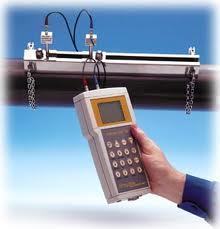What is an Ultrasonic Flow Meter?
An ultrasonic flow meter emits an ultrasonic signal through a liquid and receives the echoes that are reflected off of air bubbles and other discontinuities within the liquid in order to determine the liquid’s speed through its container. Ultrasonic flow meters are used in waste water and other applications that involve changes in pressure or chemicals. Ultrasonic flow meters are ideal for many applications because they require little maintenance and can be used from a remote location.
How Ultrasonic Flow Meters Work
An ultrasonic flow meter has two separate piezoelectric transducers that convert electricity into sound and sound into electricity. One piezoelectric transducer is installed as a transmitter and emits an ultrasonic signal while the other transducer is installed as a receiver to receive the ultrasonic signals as they are reflected off of discontinuities in a liquid. The ultrasonic flow meter itself is attached to a long pipe that sits in the liquid being tested. As ultrasonic signals are broadcasted into the pipe, they travel through the liquid and bounce off of air bubbles, suspended particles, or other small objects that are floating in the liquid. The ultrasonic signals then travel back through the pipe and arrive at the ultrasonic flow meter with a slightly different frequency than when they were emitted. This frequency difference is proportional to the rate of flow of the liquid and can be measured to determine the liquid’s speed.
Applications
Ultrasonic flow meters are used in a wide variety of applications to measure the flow of liquids. They can be used with waste water, pure water, oils, chemicals, and liquid gases. Offshore oil platforms usually have ultrasonic flow meters in order to determine the rate of flow of the oil being piped out of the ocean floor.
Advantages
Ultrasonic flow meters have several important advantages that allow them to be used in their various applications. They produce ultrasonic signals whenever electricity is provided to them, which allows them to be operated from remote locations. Ultrasonic flow meters can also be readily manufactured and installed whenever the need arises. They are harmless to people and animals around them and do not generate noise that humans can hear.


Comments - No Responses to “What is an Ultrasonic Flow Meter?”
Sorry but comments are closed at this time.